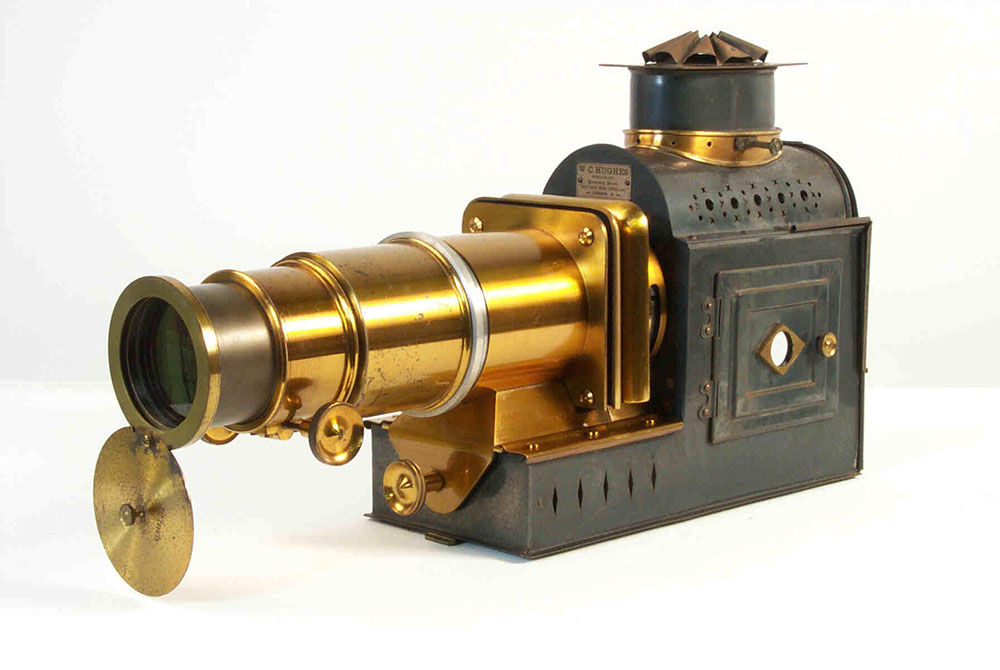Magic lanterns are a form of slide projector which have been around for centuries, but had their heyday in the 19th century. Public magic lantern shows offered education and entertainment through a combination of images (both still and moving), music and song, before cinema projection was possible.

The earliest slides were hand-drawn and hand-coloured images depicting pretty much anything that could be imagined. Here’s an example of seasonal good cheer:

But, from the 1870s, life model slides began to be produced. These are magic lantern slides in which the images are photographs of costumed models posed in scenes or locations to illustrate stories, songs, hymns and poems. Typical subjects included tales warning against the dangers of alcohol and other social vices, popular songs, recitations, comic subjects and religious services. They would come in sets of slides which were 8cm x 8cm; these could consist of anything from 2 to 60 slides, but averaged 12. They would be projected one after the other showing the key action with a lanternist narrating the tale.
The models (often local volunteers or the photographer’s family and friends), furniture and other props would be placed in front of hand-painted backcloths. The resulting photographs were then mass produced in both black-and-white and hand-coloured versions—black-and-white ones were cheaper as no artists had to be paid to colour the slides. Different versions of the same basic sets can often be found, as the artists were able to choose the colours they felt most appropriate.
There are surprisingly few life model sets among the thousands of magic lantern slides we have in the museum’s collection, but one of the ones we do have has a Christmas theme—so it feels like the right time of year to show it.
A Terrible Christmas Eve is a slide set made by W Rider and Co in 1894. Originally it had 24 slides; we only have 19, but it still makes sense as a story, so may have been used this way or a few may have been lost over the years. This set also has a WMSSU label on it, which is the Wesleyan Methodist Sunday School Union, and it may be that this set formed part of their lending library. Many religious organisations made use of lantern shows as an educational tool, and this story does have a Christian outlook.
These slides sets also came with readings, which the lanternist would read out to accompany the relevant image. The Magic Lantern Society has a large collection of these readings so we know what would have been said alongside each image (unless the reader went off-text, which they could do). These are reproduced in part alongside a selection of the slides here.
The story begins in a cottage by the sea where the angry roar of the ocean is the only sound to be heard. The family are about to be torn apart as the sailor husband must leave to rejoin his ship upon the dangerous waves, leaving his wife and baby at home with only their prayers to keep him safe. Then the child falls ill.

‘The babe is ill, and at his wailing cry, the mother shudders—hope has almost fled’
Happily, the child recovers from his illness and the woman (Nell) finally receives word from her husband.

‘And joyful morn! The postman brings a greeting, “I’m coming back again to you, sweetheart”’
It is at this point that the reading tells us it is Christmas Eve and as Nell prepares to welcome her husband home, she looks out of the window.

‘When from her heart the life blood ceased to flow, one awful moment of suspense and doubt’
She sees a ship in distress and knows she must act. She wraps the child in its cot and heads out into the snowy storm.

‘She waves her torch—her strength is almost past—her heart is bursting—then—it seems to stop’
Nell collapses as she tries to guide the ship away from the rocky coast.

‘With shouts of praise each person present tries to rouse the fainting girl as best they may’
Nell is discovered by a search party just in the nick of time (the slightly odd-looking body wraps the rescuers are wearing are one of the earliest types of lifejackets, made of cork, first brought into use in the 1850s).

‘Tis Christmas morn! All hearts are filled with joy, And Jack and Nellie praise their God above; their gladness knows no ending, no alloy, They have each other and the babe they love’
As you might expect, the story has a happy ending—although that is certainly not always the case for life model slide sets, particularly those with strong moral messages for those who do not change their wicked ways.
Life model slides provided both populist entertainment and guidance about health and social wellbeing through simple narratives. The visual storytelling engaged audiences, and the opportunity to participate—joining in with singing songs, for example—provided a fun group activity. Many of the stories had a melodramatic or moral theme, while some were more comedic; in fact just the kind of tales which film-makers have continued to tell throughout the history of moving pictures.